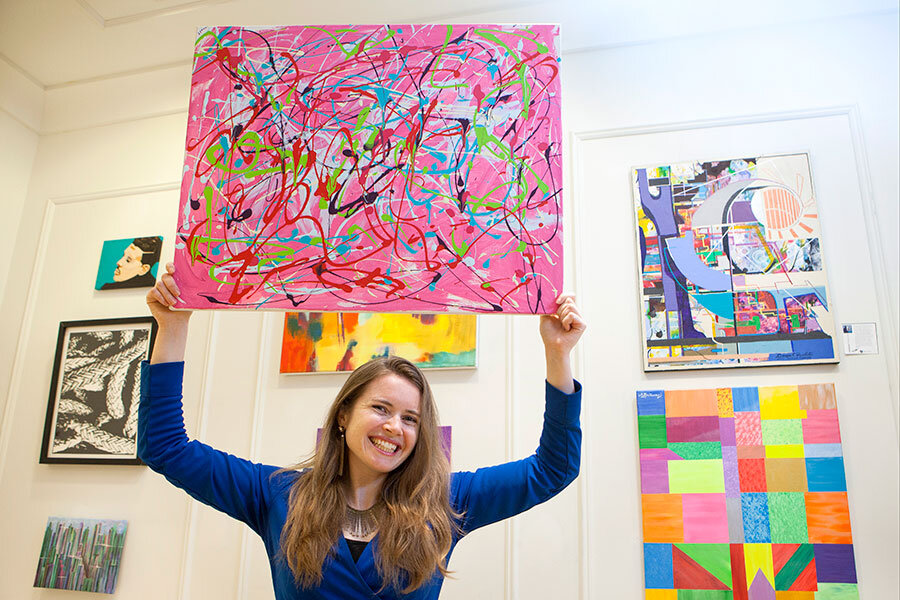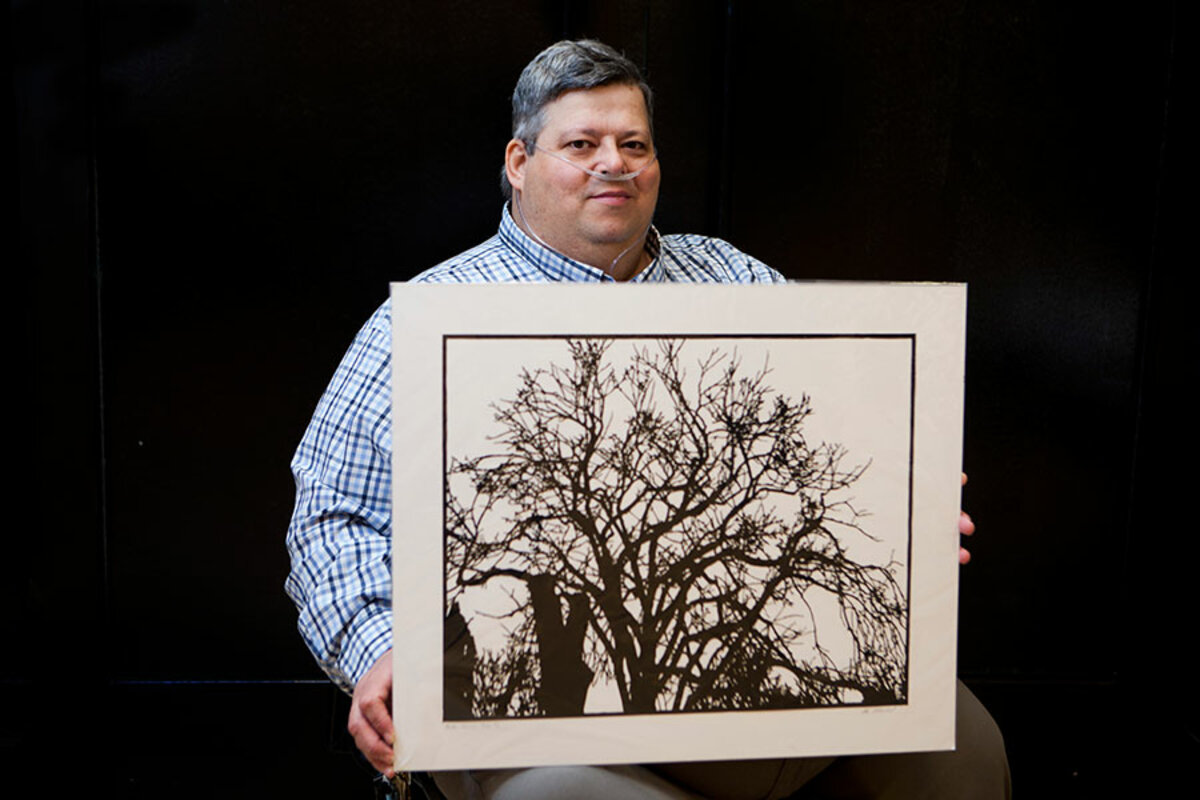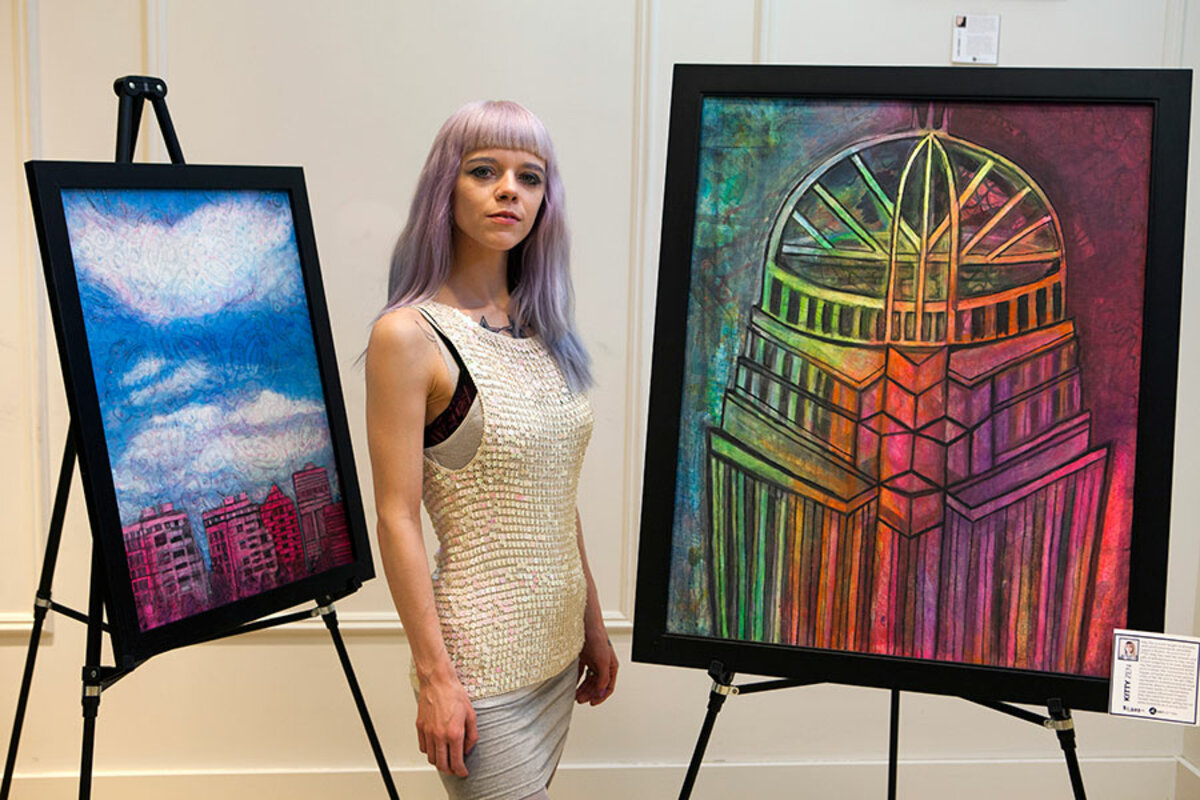Meet the woman who helps disabled and homeless artists sell impressive work
Loading...
| Cambridge, Mass.
Her first realization came when she was running art programs at homeless shelters and noticed there was amazing art piling up and going nowhere. Her second was when she organized a Boston exhibit of that work by homeless and disabled artists and found that people actually wanted to buy it.
Connecting the dots, Liz Powers created the brokerage ArtLifting in November 2013. And within 18 months she and Spencer Powers, her business student brother, had sold six figures’ worth of art – enabling five artists to find housing. Then came investors with $1.3 million to take the Boston program national and hire a staff of curators and marketing specialists.
Who would have thought?
When Ms. Powers, a 2010 Harvard sociology graduate, told her interior designer mother about her idea to sell art made by homeless and disabled people, the response was, “Is there enough art that is great-looking?” When she explained the idea to her Harvard sociology professor, Tim Nelson, his first thought was, “Is there a market for this? I don’t know [whether] people would just be buying it out of pity.”
But, says Powers, whose staff works with art programs that identify outstanding artists and carefully curates what is offered for sale, “we totally turn that on its head. These are incredibly talented artists, and almost all of them are totally self-taught and just have raw talent, which makes it even more impressive that, despite the challenges they’ve faced their whole life, they’ve created this amazing beauty.”
Indeed, Janet Howe, who recently bought a $1,700 abstract painting for the foyer of one of her Boston-area homes, says, “It’s not what you think.” The 40-by-40 original – by Randy Nicholson, whose career and ability to find housing have been affected by bipolar disorder – stuns guests with its vibrancy, she says. “They say, ‘Where did you get this?’ No one would ever guess.”
And there is an air of the unexpected when you walk into ArtLifting’s gleaming, temporary gallery in Cambridge, Mass., or click through the company’s elegant online catalog of art and products like cellphone covers and tote bags. Most obvious is the brightness: There’s not a single morose vision from the depths of hardship.
And then there’s the high quality.
“It’s all about perception: You’re definitely not fly-by-night if you’re working with a gallery,” says Allen Chamberland, who began doing intricate cutwork of Boston landmarks after he couldn’t work; he uses a wheelchair because of physical disabilities. He recalls the days when he’d display his work on the ground at busy spots around Boston. They sold for $65 apiece, but he inched the price up to $100 as he graduated to propping them up on tables.
Today, his originals sell for as much as $2,000 – and they’ve been bought by the Staples corporate headquarters, Red Sox owner John Henry’s family, and Harvard, which has commissioned six works from him.
“I’ve actually had to file taxes the last two years, [and] it feels good,” Mr. Chamberland says. And “I’ve taken in more at this point in the year than I made all of last year.”
Kitty Zen, homeless since high school after fire destroyed her family home as well as her art portfolio, says her ArtLifting earnings provide enough to buy a monthly subway pass and keep her cellphone on.
The fact that her family’s insurance company valued some of her lost paintings at $300 each buoyed her, she says, even if she couldn’t get galleries to carry her art. But ArtLifting, she says, “is professional representation that is helping to shatter a lot of barriers and the [homeless] stereotypes that exist.”
These stigmas are among Powers’s chief targets. Since her freshman year at Harvard, she has worked in the homeless community – serving shelter meals, doing casework, and entrepreneurially tinkering with more sustainable ways to help. While still in school, she hatched a program to give donated bikes to the homeless.
Those who work with Powers say she’s relentlessly happy, refusing to let the hardships of violence, disability, poverty, and just plain old misfortune define her clients.
Her brother recalls shock when ArtLifting’s first publicity brought in 100 Christmas orders valued at about $10,000 total in the middle of a transit-challenged snow season. “I was super-stressed about how to fill all the orders, and Liz was like, ‘Isn’t this great?’ Even faced with a ton of work, she was only focused on the positive aspects.”
Powers stresses that ArtLifting is not about handouts, but payouts: “We are not a charity, which people often assume. We’re a for-profit social enterprise, and we’re really proud of that.”
As a “benefit corporation,” the company lets social good take precedence over profits, but profit is a goal. While she won’t discuss those profits, Powers describes rapid expansion: Big-name investors, such as TOMS shoes founder Blake Mycoskie and Eric Ries, the “lean start-up” pioneer, have helped. The company represents 80 artists in 11 cities, has nine employees, has made large corporate sales to Microsoft and Bain & Co., and has a licensing agreement with Leesa – a high-end, direct-to-consumer mattress company – to sew art into mattresses. The two companies just opened a combined store and gallery in New York’s SoHo neighborhood.
Artists get 55 percent of their own sales, the company gets 44 percent, and 1 percent funds supplies to art groups nationwide.
“Extreme optimism” is behind Powers’s ability to listen humbly to her clients as well as negotiate the hurdles of long-term funding, says Maria Dominguez Gray of Harvard’s Phillips Brooks House Association, which gave a grant for Powers’s early work. She credits Powers with “thinking outside the box” of her nonprofit background, while “keeping it honest.”
“I was very cautious at first and still am as they expand, because figuring out what the bottom line is is important when you have a social-good mission,” Ms. Gray notes.
The frustrations of the nonprofit rhythm – applying for a $5,000 grant and not seeing the money for a year, for example – didn’t make for a sustainable path to “helping invisible individuals become visible,” Powers says.
But business sense does little if clients don’t have hope, she says.
She recalls that when clients in her art groups would ask what they should do, there’d be pushback if she specified something. But her spontaneous suggestion uncorked the creative flow: “Paint hope.”
How to take action
Universal Giving helps people give to and volunteer for top-performing charitable organizations around the world. All the projects are vetted by Universal Giving; 100 percent of each donation goes directly to the listed cause. Below are links to three groups promoting arts-related efforts:
Shirley Ann Sullivan Educational Foundation improves the quality of life for children by providing education and lobbying for their protection from exploitation. Take action: Help fund arts education.
Cultural Canvas Thailand generates awareness and volunteer support for the current social issues facing Chiang Mai, Thailand. Take action: Promote cultural awareness with Art Relief International.
Asia America Initiative builds peace, social justice, and economic development in impoverished communities beset by conflict. Take action: Keep 500 children away from terrorist control through education and the arts.










